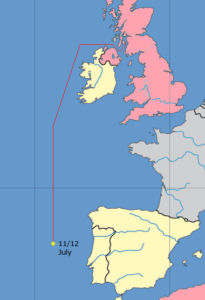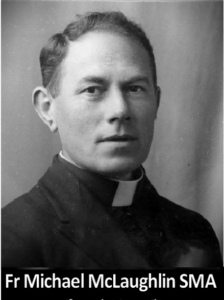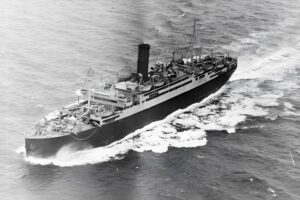 This article was recently re-published in the African Missionary Magazine, No 43, Spring – summer 2024. It is an edited version of an account written by Father Michael McLoughlin, SMA, telling of his eventful voyage to Nigeria during the Second World War. It was first published in the March/April 1964 issue of the African Missionary. Fr McLoughlin, from Kilmeena, Co Mayo, was ordained in 1930. He was fifty-three years in Nigeria, working in the vast territory of Yorubaland. He spent most of his time in what today constitutes the
This article was recently re-published in the African Missionary Magazine, No 43, Spring – summer 2024. It is an edited version of an account written by Father Michael McLoughlin, SMA, telling of his eventful voyage to Nigeria during the Second World War. It was first published in the March/April 1964 issue of the African Missionary. Fr McLoughlin, from Kilmeena, Co Mayo, was ordained in 1930. He was fifty-three years in Nigeria, working in the vast territory of Yorubaland. He spent most of his time in what today constitutes the  Archdioceses of Lagos and Ibadan, and the Diocese of Ijebu-Ode.
Archdioceses of Lagos and Ibadan, and the Diocese of Ijebu-Ode.
In 1943 I was due to return to Nigeria after a long-delayed holiday in Ireland. Getting back proved even more difficult than getting home. Berths were secured on board the once luxury liner “M V California” sailing from Glasgow. Now a troop ship, it was painted grey and bristled with guns. Cabins designed for four now held eight. But one could not complain, the important thing was to get back, however uncomfortable or long wartime detours might make the journey. In spite of air cover many ships on the West African route had been bombed or torpedoed. We crossed our fingers as we sailed past Ireland heading west into the Atlantic on 7 July 1943. There were twenty-five missionaries on board, among them twelve SMA’s and seven members of the Sisters of Our Lady of Apostles (OLA). Our convoy was a small one of three ships, guarded by two destroyers and a sloop.

We turned south, towards Africa, far out in the Atlantic. On the afternoon of 10 July there were loud explosions as the destroyers dropped depth charges. We must have attracted submarines. On the following day, about 7pm, we had an alert after dinner. Worryingly the “All Clear” did not follow but we could see nothing, nor hear the sound of enemy planes. The suspense mounted and we waited. Without warning all the ship’s guns opened up a terrific barrage. The din was absolutely deafening and every part of the ship vibrated. Suddenly there was a terrific explosion and the ship lurched badly. Next a second and more deafening explosion rocked the ship from stem to stern. The engines went silent. While the guns above us were firing as hard as ever, we knew the ship had suffered severe damage. In the light of torches, I saw the wreckage along the corridor outside. Occasional moans seemed to come from the debris. Soon we heard the call: Abandon ship. Life-boat Stations!
On the boat-deck we could see the fore-part of the ship in flames. “M V Duchess of York” was afire amidships about a quarter of a mile away. Overhead, I could hear the drone of planes but could barely see them. They remained too high for the range of the ship’s guns. As we were lining-up at our life-boat positions, another order sent us scampering: “Action Stations”! But our gunfire held off the attackers and we returned to the life-boats. The wounded and women went first. Two of the priests had to swim for it and were eventually picked up. We saw many clinging to scraps of floating wreckage and rafts.
As we got some distance away we could see the whole ship was an inferno, with loud explosions as ammunition stocks blew up. One of the priests who was near the Purser’s office when the last bomb hit, was hurled along the corridor by the force of the blast. I scarcely recognized him with torn clothing, a blackened and bleeding face. Final rescue came in the form of a destroyer already crowded with survivors from the “M V Duchess of York”. The victims of the explosion were horribly wounded or burned. This was certainly war at close quarters.

The destroyer set course for Casablanca. With only the clothes on our backs we now felt what it meant to be destitute and how much the trifling baggage we lost really meant to us. Several “alerts” were sounded during the day but an attack did not follow and we felt immense relief when the “All Clear” sounded.
On Tuesday, 13 July, we docked in Casablanca, Morocco. The American forces welcomed us ashore and gave us a fine reception, provided us with everything, including army uniforms to change into, beds and accommodation. We then learned that one hundred and ninety souls were lost from the two ships. Thankfully all twenty-five missionaries were safe, suffering nothing more than shock.
It took two weeks before we finally got under way on another boat, the “TSS Nea Hellas”. We reached Freetown in six days. From there we boarded the “RMS Tamaroa” and sailed down the west coast of Africa, without incident, to Lagos. With only uniforms to declare at the Customs, we got through easily. I was, at last, back safe and sound in Nigeria.

